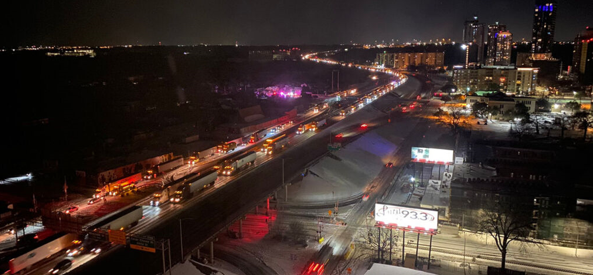
Hyper Segregated Austin not a Vestige of a Bygone Era, but a Product of Intentional Design
“Racism and inequity are products of design. They can be redesigned.” I first heard these words from Dr. Christine Ortiz, founder of Equity Meets Design, as she guided me and a cohort of other education leaders through her course on design thinking through an equity lens.
I have thought often of those words since that moment, but rarely more than during Leadership Austin Essential’s class on Austin’s built environment. What is our built environment, you ask? All of the human-made physical spaces where we live, work, and play. Buildings, furnishings, public and private spaces, roads, utilities, and infrastructure.
Cohort 43 had the opportunity to learn from Lauren Lluveras, Sam Tedford, and Awais Azhar about the ways in which the racism and inequity of Austin’s built environment are indeed products of intentional design. I have known that Austin was plagued by gentrification since my days as an undergraduate at UT, and that many prominent early Austinites were enslavers who exploited the labor of others to build their fortunes, but I didn’t realize that the foundation of many of the inequitable outcomes that residents of color in Austin experience today were intentionally and explicitly designed by the government and corporate interests of the past.

Particularly appalling were the details of the 1928 City Plan that relegated non-White residents to East Austin, along with most toxic industry. This in combination with nationwide White Supremacist phenomena such as redlining and racially restrictive real estate covenants that prevented homeowners from selling their property to non-White buyers, created the pattern of segregation that we still see today. As recently as last year’s deadly winter storm Uri, the impact of this historic segregation can be seen in the stark contrast between east and west of I-35, seen above as captured by CBS Austin. A shot of I-35 during Winter Storm Uri, when much of the eastern crescent was without power for days. Photo credit: CBS Austin.
In successive decades, politicians and business leaders were savvy enough to veil their intentions in language that didn’t explicitly name continued segregation and the hoarding of wealth and power by White Austinites as objectives, but nevertheless that was the outcome of the urban renewal plans of the 50s and 60s and even of the environmental protections won for West Austin in the early 90s. Despite continual resistance efforts by those most impacted by these policies, meaningful victories were few and far between.
Although it would be easy to despair given how intractable much of the outcomes of this history seem, there are yet glimmers of hope. Austin’s current city council is the most diverse in our history, with better representation for our populace and council members who are responsive to the concerns of their constituencies. In 2018, the council approved of Right to Stay and Right to Return policies for neighborhoods at greatest risk of continued gentrification, which are being implemented for the first time in a development planned for the St. John neighborhood, championed by District 4 Council Member Greg Casar. And even though potentially toxic development is still concentrated on the East side, community members are pushing back and winning important concessions such as the recent decision by city council to require an environmental impact study of the South Airport jet fuel storage site on the air and water quality, proposed by District 2 Council Member Vanessa Fuentes.
While these examples represent a step in the right direction, we cannot achieve the scale of change necessary to reverse centuries of oppressive policy until all of us confront our roles in the current system, and seek solutions that include the voices of all Austinites, especially those most impacted by the inequitable outcomes that are a result of policies that are still working exactly as they were designed. If Austin truly wants to live up to its reputation as a bastion of progressive thought and action, it is time to design new policies with as much intentionality as those that came before.

Ashley Prevost, Essential 43 – Class 2022
Assistant Director of Instructional Leadership
Texas Education Agency
Ashley is a leader in education, and mother of two who has made Austin her home for the past eleven years, and is eager to continue learning more about leveraging interconnected systems to work toward greater equity. Connect with me on LinkedIn
Words expressed in this blog post do not belong to Leadership Austin. These are the experiences and thoughts of a member of the Essential 43 cohort, where community leaders of diverse backgrounds explore difficult issues impacting our region.
